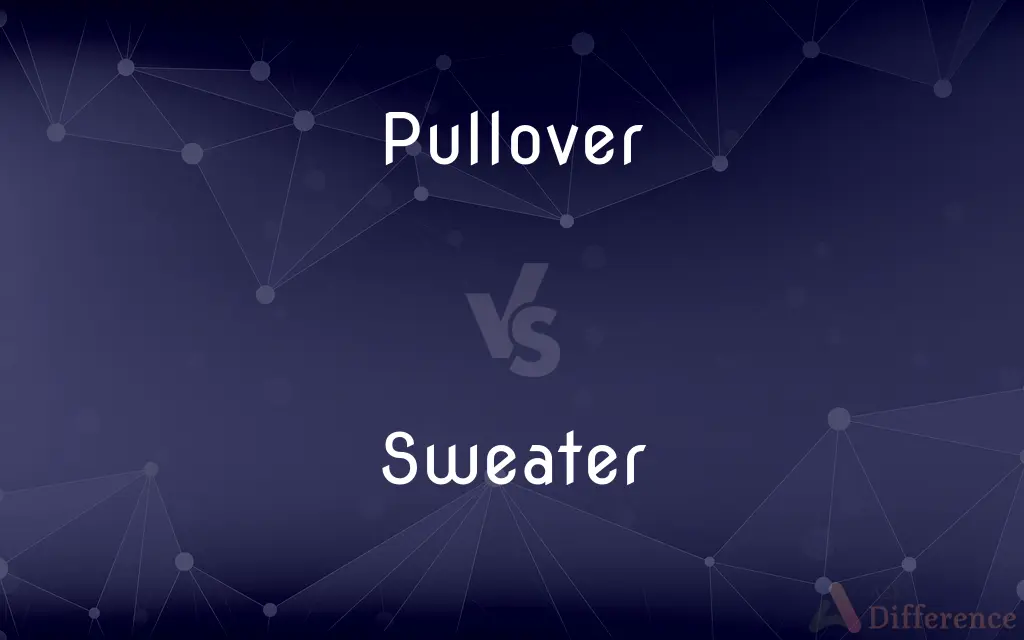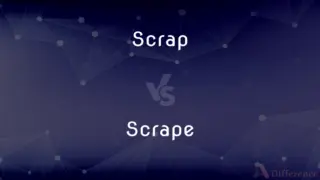Pullover vs. Sweater — What's the Difference?
Edited by Tayyaba Rehman — By Fiza Rafique — Updated on September 25, 2023
A pullover is a garment slipped over the head without a front opening, while a sweater is a knitted garment for the upper body, which can include pullovers, cardigans, and more.

Difference Between Pullover and Sweater
Table of Contents
ADVERTISEMENT
Key Differences
A pullover and a sweater both refer to garments intended to provide warmth, especially during colder seasons. The term pullover specifically denotes a style where the garment is put on by pulling it over the head, as it lacks a front opening. On the other hand, a sweater is a broader term that encompasses various types of knitted upper body garments, including pullovers.
Not all sweaters are pullovers, but all pullovers can be considered sweaters. For instance, cardigans, which have a front opening (usually buttoned or zipped), are a type of sweater but not a pullover. The distinct feature of a pullover is its lack of front opening, making it a subtype within the sweater category.
From a material perspective, both pullovers and sweaters are typically made from wool, cotton, or synthetic fibers. The emphasis for both is on providing warmth. The distinction arises from design and functionality. While a pullover is typically a simple, slip-on garment, sweaters can come in various styles, patterns, and designs, including those with front openings, turtlenecks, or even hoodies.
In everyday conversations, many people might use the terms pullover and sweater interchangeably, especially if the specific type of sweater isn't crucial to the discussion. However, in fashion and retail contexts, the differentiation becomes more critical as it can dictate the garment's style and wearability.
Lastly, while pullovers are predominantly casual wear, the term sweater is more versatile, encompassing both casual and formal styles. This versatility allows sweaters to be paired with various outfits, from jeans to dress pants, emphasizing their adaptability in fashion.
ADVERTISEMENT
Comparison Chart
Design
Lacks a front opening
Can have a front opening or be closed
Style Variations
Typically one main style (over-the-head)
Includes multiple styles (cardigans, turtlenecks, pullovers, etc.)
Wearability
Predominantly casual
Ranges from casual to formal
Umbrella Term
Is a subtype
Is an overarching term
Compare with Definitions
Pullover
Slipped on by pulling it over the head.
The pullover was so cozy, perfect for winter.
Sweater
Can vary in style, from pullovers to cardigans.
The store had a sale on all sweaters, including turtlenecks.
Pullover
Typically knitted or crocheted.
The intricate patterns on the pullover caught everyone's attention.
Sweater
Designed to provide warmth.
The woolen sweater kept him warm during the snowy day.
Pullover
A garment worn on the upper body without a front opening.
He wore a blue pullover to the evening bonfire.
Sweater
Made from various materials like wool, cotton, or synthetics.
The cotton sweater was lightweight and perfect for fall.
Pullover
Provides warmth and is often worn in colder seasons.
She always packed a pullover for her mountain trips.
Sweater
Worn both casually and formally, depending on design.
He wore a sweater over his shirt and tie for the business meeting.
Pullover
Often made from wool, cotton, or synthetic fibers.
The cashmere pullover was a luxurious gift.
Sweater
A sweater or pullover, also called a jumper in British and Australian English, and a windcheater in parts of Australia, is a piece of clothing, typically with long sleeves, made of knitted or crocheted material, that covers the upper part of the body. When sleeveless, the garment is often called a slipover or sweater vest.
Pullover
A garment, such as a sweater, designed to be put on or taken off over the head. Also called slipover.
Sweater
A garment for the upper body of wool, cotton, or synthetic yarn, typically knitted, having long sleeves, and worn in cold weather.
Pullover
A sweater that must be put on by pulling it over the head; a sweater without buttons or a zipper in front
Sweater
One that sweats, especially profusely.
Pullover
(weightlifting) An exercise performed lying on the back in which the arms are extended behind the head and exertion lifts the weight above the head.
Sweater
Something that induces sweating; a sudorific.
Pullover
An exercise in which the gymnast pulls up from a hang lifting the legs up and over the bar thus rolling into a support position.
Sweater
A knitted jacket or jersey, usually of thick wool, worn by athletes before or after exercise.
Pullover
An instance of a vehicle being pulled over.
Sweater
(US) A similar garment worn for warmth.
Pullover
A sweater that is put on by pulling it over the head
Sweater
One who sweats (produces sweat).
Sweater
One who or that which causes to sweat.
Sweater
A diaphoretic remedy.
Sweater
(historical) An exploitative middleman who subcontracted piece work in the tailoring trade.
Sweater
(archaic) One who sweats coins, i.e. removes small portions by shaking them.
Sweater
A London street ruffian in Queen Anne's time who prodded weak passengers with his sword-point.
Sweater
(transitive) To dress in a sweater.
Sweater
One who sweats.
Sweater
One who, or that which, causes to sweat
Sweater
A crocheted or knitted garment covering the upper part of the body
Sweater
A person who perspires
Sweater
A knitted garment worn on the upper body.
She paired her jeans with a red sweater.
Common Curiosities
Is every pullover a sweater?
Yes, every pullover can be considered a sweater.
Can a sweater have buttons?
Yes, a sweater with buttons is typically called a cardigan.
Can a pullover have a hood?
Yes, some pullovers come with a Ahood, often called hoodies.
Why do some pullovers have a V-neck design?
V-neck pullovers allow for showing off a shirt or tie underneath and can be a style preference.
Does a pullover always lack a front opening?
Yes, a distinguishing feature of a pullover is its lack of a front opening.
How should I wash my woolen sweater?
Woolen sweaters should be hand-washed gently in cold water or dry-cleaned.
How do I prevent my pullover from pilling?
Avoiding harsh washing and drying, and using a fabric comb can help prevent pilling on a pullover.
Can sweaters be cropped in length?
Yes, cropped sweaters, shorter in length, are a popular fashion choice.
Are all sweaters knitted?
Most sweaters are knitted, but they can also be crocheted or made from other methods.
What's the difference between a sweater and a jumper?
In American English, "jumper" and "sweater" are often used interchangeably. However, in British English, a jumper is akin to the American sweater.
What materials are common for sweaters?
Wool, cotton, and synthetic fibers are commonly used for sweaters.
Is a pullover suitable for formal occasions?
While some pullovers can be dressed up, they're predominantly considered casual wear.
Are pullovers always long-sleeved?
While common, not all pullovers are long-sleeved. Some might be sleeveless or short-sleeved.
Can sweaters be sleeveless?
Yes, sleeveless sweaters, often called sweater vests, are a type of sweater.
Is it okay to hang my sweater?
It's best to fold sweaters to maintain their shape. Hanging can cause them to stretch.
Share Your Discovery

Previous Comparison
Scrap vs. Scrape
Next Comparison
Assonance vs. ConsonanceAuthor Spotlight
Written by
Fiza RafiqueFiza Rafique is a skilled content writer at AskDifference.com, where she meticulously refines and enhances written pieces. Drawing from her vast editorial expertise, Fiza ensures clarity, accuracy, and precision in every article. Passionate about language, she continually seeks to elevate the quality of content for readers worldwide.
Edited by
Tayyaba RehmanTayyaba Rehman is a distinguished writer, currently serving as a primary contributor to askdifference.com. As a researcher in semantics and etymology, Tayyaba's passion for the complexity of languages and their distinctions has found a perfect home on the platform. Tayyaba delves into the intricacies of language, distinguishing between commonly confused words and phrases, thereby providing clarity for readers worldwide.
















































